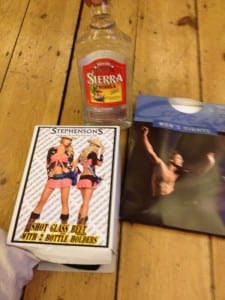All the musical elements for Three Words are coming together. The number of Music rehearsals has been doubled and the harmonies are being nailed. Like in my previous blog, some of the performers were finding it difficult to get and keep the correct harmonies. Therefore we have had to change a harmony in All you need is Love into two parts, however over the past couple of days, one of our performers Sam was able to pick up a newly revised third harmony which was what the piece was missing. I was able to leave Sam to sing the harmony, as she is one of our most confident singers. She has been a great help in helping the group pitch some of the most difficult harmonies. In adding the third harmony back in, I think it has given the song a stronger texture. The only thing worrying me now is the tone. It is coming after a difficult section, but will in theory and hopefulness lift up the audience’s mood and helps them believe love is all you need. In keeping with the song, our group had a moment of pure genius while rehearsing in Jozey’s bedroom. It was difficult to try to come up with a way to end the piece. At this point the lengthy music rehearsal was getting to everyone and we were going to give it a rest for the day. But then something magical happened. I am describing it as magical because it gave me Goosebumps and as it began to unravel glockenspiel master Becky’s face lit up with excitement. All the hard work the singers put in that day had paid off with a great ending of what can only be described as a love line mash-up. Here is an example:
Of course after the magic, became the practicality of directing at which point will the build up start, who will start it, how long will it go on for and how will it end? But I felt as musical director; after the hours spent it really is true that in a moment of pure spontaneity something amazing can be created. Jozey and Phoebe will lead the group to start and through the direction of myself and Jozey voices will gradually be added into the mix until it reaches a point. Then the guitar playing will cut out and voices will begin to fade out to leave phoebes last line… love is all you need. I think this will be a lovely way to end such a chaotic and unique piece and in a way is a symmetrical to the beginning.
From this point on all ‘Three Words’ needs is its finishing touches to the performance. Some of the parts required some enhancement. In particular during First Kisses one of the performers, Abbi’s line is ‘It was during an S Club 7 song’ at which point anyone around her bursts into a dance to Reach. Instead of using a soundtrack it would be nice if the motif was played on piano. Another thing we added late on into the performance was the Imperial March. This replaced the wedding march in the wedding scene as we thought it would add another aspect to the ever changing hilarity of the performance. These little moments of music come within in some light and funny pieces.
As well as adding little bits into the performance in order to fill the silence between the little scenes and to make the piece more flowing, it was decided that the transitions will be a mixture of guitar, piano, verbatim and in some cases spontaneous song but together by myself, Jozey and Tom. The piano parts in particular, some were created using simple chords and others were parts of songs featured in the piece. This I hope will help to tie all of the little sections together and polish up any scene changes.
At this point, I am feeling confident that the all the elements especially the music shall be good. With only a week to go, the big numbers just need polishing and the individual music needs practising but I am confident in saying as a company we have put our heart and soul into the performance, challenged ourselves and from my point of view with help from the fabulous Jozey the music is where at the standard if not above what I am hoped from the beginning of the process. I just hope in this next week we can build it up more and give the audience something amazing to watch and listen too!
7 days left… No Added sugar … Three Words… LET’S DO THIS!

